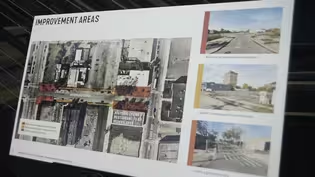
Pewabic: One of nation’s oldest pottery, ceramics factories
Clip: Season 9 Episode 5 | 5m 57sVideo has Closed Captions
One Detroit visits Pewabic, one of the nation’s oldest ceramic and pottery factories.
Over in Detroit’s East Village, a neighborhood by the river on the city’s east side, you’ll find a working piece of machinery that’s been operating since the time of Henry Ford’s Model T. The Pewabic Pottery ceramics factory has been running its antiquated clay mixing machine since 1912. One Detroit’s Bill Kubota visits Pewabic to learn about its history and how it’s still going strong today.
Problems playing video? | Closed Captioning Feedback
Problems playing video? | Closed Captioning Feedback
One Detroit is a local public television program presented by Detroit PBS

Pewabic: One of nation’s oldest pottery, ceramics factories
Clip: Season 9 Episode 5 | 5m 57sVideo has Closed Captions
Over in Detroit’s East Village, a neighborhood by the river on the city’s east side, you’ll find a working piece of machinery that’s been operating since the time of Henry Ford’s Model T. The Pewabic Pottery ceramics factory has been running its antiquated clay mixing machine since 1912. One Detroit’s Bill Kubota visits Pewabic to learn about its history and how it’s still going strong today.
Problems playing video? | Closed Captioning Feedback
How to Watch One Detroit
One Detroit is available to stream on pbs.org and the free PBS App, available on iPhone, Apple TV, Android TV, Android smartphones, Amazon Fire TV, Amazon Fire Tablet, Roku, Samsung Smart TV, and Vizio.
Providing Support for PBS.org
Learn Moreabout PBS online sponsorship- [Bill] A fixture on Detroit's East Side on Jefferson in East Village, Pewabic Pottery, where you'll see a really old clay mixing machine.
- It was made very well back in 1912, and it's still operating today, like a charm.
- [Bill] Pewabic Pottery, turning out ceramic vases, decorative and architectural tiles.
A Detroit legacy that goes back to the turn of the last century.
- Well, I think that's kind of the beauty of Pewabic is we started at a time where this was really popular throughout the United States, but we are really one of the oldest continuously operating historic potteries.
So, not many more left like us.
- [Bill] Pewabic was thriving in the 1920s, part of the Arts and Crafts movement.
a reaction to the industrialization sweeping the nation, especially places like Detroit, how to bring some humanity, art, and beauty amongst all these machine made things.
Meanwhile, dental equipment supplier Horace Caulkins created a kiln to fire enamel for porcelain teeth.
- Horace was a really good business person, and so, kind of realizing that there was this entire new art trend growing within the city of Detroit, known as China painting, he expanded his line of kilns into kilns for the firing of pottery.
- [Bill] Caulkins began working with the China painter, Mary Chase Perry.
- Well, our founder, Mary Chase Perry, later Mary Chase Perry Stratton, was born in Hancock, Michigan.
- [Bill] Hancock, in the upper peninsula with its copper mines, including a mine called The Pewabic.
Stratton liked that name.
- Mary was really the artistic vision of the organization, and that was something that was fully supported by her business partner.
- [Bill] Education Director Annie Dennis has been discovering Pewabic's history, doing a deep dig into the archives.
- We are finding that she had connections to the Detroit suffrage movement, and I think it was really inspiring for women artists to find a woman run organization.
And that's no different today.
I think the coolest and best part about Pewabic, and not just today, but just historically, are the people that continue to be drawn to this place and care for it.
- [Bill] Back in the clay mixing room, Cameron Hodge runs the machine that removes excess water.
- This is still one of the best ways that you can produce clay.
My last major position was as a distiller, and it was actually a very similar process of mixing a batch of whiskey and then mixing a batch of clay, so that's actually how I got hired on in fabrication.
- [Bill] The molds that shape the clay, for a lotta projects, the process, pretty much the same as it's always been.
- Take the slug, put it into the mold, use my arbor press to press it into all the corners.
I like when the public comes around because it is a nice reminder of like how special this job actually is that we to make these tiles that some of 'em are about 100 years old as far as the design goes.
And just continuing the legacy and being a part of the history of Detroit, it's pretty cool.
- [Bill] After the shaping, some get a spray coat.
These tiles, an original Stratton design, hand painted by glaze technician Cassidy Downs.
Then comes the firing, but the process isn't all old school.
Brett Gray's in the kiln room.
- I have a degree from CCS in ceramics.
Before that, I made custom surfboards, and then I ended up here working in the vessel department.
The biggest difference between historic kilns and these kilns are these are all computer controlled, and we do about five different glazes in here right now.
So as I'm pulling these out, I'm kinda looking over them to make sure everything looks good, there's no imperfections.
These came out perfect.
99% of the time they do.
- It's hard to talk about Pewabic glazes without starting with iridescent glazes because it's really what essentially helped to put Pewabic on the map well over 100 years ago.
- [Bill] Glazes with an iridescent finish.
- [Brett] So this is a before and after, before it goes into iridescent.
This one has the iridescent on it, which is also a third firing.
- [Bill] Here's where art and science converge.
In the old days, elements like lead and uranium gave these works, which you can see at the museum here, that remarkable luster.
These finishes replaced with far less hazardous materials now.
Stratton's work brought together other creatives, who established modern Detroit's legacy of art and design.
- I really think it was this network of designers and architects and artists that kind of helped to form the path of Pewabic Pottery.
And this group not only influenced the aesthetics of the city of Detroit and kind of this visual landscape, but also the educational communities.
For example, the Detroit Society of Arts and Crafts is still alive and well in Detroit.
It's now known as the College for Creative Studies.
They also had ties to the University of Michigan.
In fact, Mary helped to found the art program at U of M. The first Wayne State University ceramics classes for the first 15 years, existed here at Pewabic.
- [Bill] Pewabic tiles abound around Detroit, projects, old and new, the Guardian building, the Detroit Institute of Arts, Comerica Park, and now, right now, renewed interest about what's going on at Pewabic.
- The digital age that we're in right now had people refocus on things that celebrate things made by the human hand, and so we're actually seeing this really incredible resurgence of people understanding now more than ever why it's important to have artists work and create things by hand.
Commemorating the 50th anniversary of President Gerald Ford's Inauguration
Video has Closed Captions
Clip: S9 Ep5 | 10m 13s | U-M Ford School of Public Policy experts reflect on President Ford’s legacy. (10m 13s)
Detroit’s Chinatown gets 1 million for improvements
Video has Closed Captions
Clip: S9 Ep5 | 4m 3s | Detroit’s Chinatown gets $1 million for improvements. (4m 3s)
One Detroit Weekend: August 2, 2024
Video has Closed Captions
Clip: S9 Ep5 | 1m 45s | Dave Wagner and Peter Whorf share what’s coming up this week in and around the city. (1m 45s)
Providing Support for PBS.org
Learn Moreabout PBS online sponsorship
- News and Public Affairs

Top journalists deliver compelling original analysis of the hour's headlines.

- News and Public Affairs

FRONTLINE is investigative journalism that questions, explains and changes our world.












Support for PBS provided by:
One Detroit is a local public television program presented by Detroit PBS


